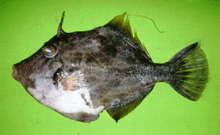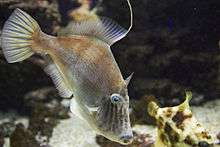Stephanolepis diaspros
Stephanolepis diaspros, the reticulated filefish, is a species of bony fish, a ray-finned fish in the family Monacanthidae. Its natural range is the western Indian Ocean but it is also one of the species which has colonised the Mediterraean through the Suez Canal by Lessepsian migration from the Red Sea.
| Stephanolepis diaspros | |
|---|---|
 | |
| Scientific classification | |
| Kingdom: | Animalia |
| Phylum: | Chordata |
| Class: | Actinopterygii |
| Order: | Tetraodontiformes |
| Family: | Monacanthidae |
| Genus: | Stephanolepis |
| Species: | S. diaspros |
| Binomial name | |
| Stephanolepis diaspros (Fraser-Brunner, 1940) [1] | |
| Synonyms[2] | |
| |
Description
Stephanolepis diaspros has a deep laterally compressed body, becoming rounded in profile ventrally. The first dorsal fin has a single strong spine with barbs on the posterior edge, which originates immediately above the posterior margin of the orbit. The second dorsal fin lies directly above and parallel to the anal fin, the second ray of the second dorsal fin is very long and filamentous, especially in males. There is no pelvic fin, just a simple flap of skin. It has a pointed snout with a small terminal mouth which contains incisor like teeth. There is a slit like gill opening and sits above the origin of the pelvic fin, Its body is covered in rough skin, rough like that of a shark, in which there are tiny scales each with a fragile spinule. On the male the caudal peduncle has several rows of horny patches. The colour of the body is brownish green or greyish green with a complex pattern of spots, dark horizontal lines and sinuous lines. There are two dark bands on the convex caudal fin, separated by a pale band while the dorsal and anal fins are yellow to orange in colour. S. diapros grow s to a maximum length of 25 cm.[3][4]
Distribution
Stephanolepis diaspros occurs in the western Indian Ocean from the Red Sea south to the Horn of Africa , along the coasts of the Arabian Peninsula to the Persian Gulf.[5][1][6] It was first recorded on the Mediterranean in 1927 off Palestine then moving northwards and westwards becoming established in the Gulf of Gabes, Tunisia after being first recorded in 1996, reaching Sicily in 1993,[3] with the first records from the Egadi Islands off far western Sicily in 2015.[7]
Biology
Stephanolepis diaspros is found in coastal waters with a rocky substrate, usually with vegetation,[1] such as algal forests or seagrass meadows.[8] It lives in small groups and feeds on small invertebrates by plucking them from rocks.[3] It has been recorded from coastal lagoons and juveniles feed in open water over sandy and muddy sea beds.[8] In Tunisian waters the breeding season extends from July to December[8] and the fish first reach sexual maturity on reaching lengths of 9.5 cm for males and 8.5 cm for females.
The diet of Stephanolepis diaspros is varied, but is dominated by crustaceans and molluscs. Algae, echinoderms, coelenterates and fish remains were also found in the stomach contents of examined specimens while sponges, hydrozoans, foraminifera and Bryozoa were also preyed on. They feed with the greatest intensity in spring but this tails off in the summer spawning season.[9]
Economic impact
Stephanolepsis diaspros is not an important commercial species in the Mediterranean basin because of its relatively small size and, in some places, it is viewed as a pest to the fishery and any specimens caught are discarded.[8] In the Gulf of Suez any specimens caught by fishermen were discarded up to the 1990s but it has become an important commercial species since the mid 1990s and there are indications that the stock is being overfished.[9]


References
- Armi G. Torres; Christine Marie V. Casal (2016). R. Froese; D. Paully (eds.). "Stephanolepis diaspros Fraser-Brunner, 1940". Fishbase. Retrieved 25 January 2017.
- "Synonyms of Stephanolepis diaspros Fraser-Brunner, 1940". Fishbase. Retrieved 26 January 2017.
- Daniel Golani; Enric Massutí; Lidia Orsi-Relini; Jean-Pierre Quignard (2002). "Stephanolepis diaspros". CIESM Atlas of Exotic Fishes in the Mediterranean Sea. CIESM. Retrieved 26 January 2017.
- "PESCE UNICORNO. Stephanolepis diaspros (in Italian)". PESCE UNICORNO. Stephanolepis diaspros. Retrieved 26 January 2017.
- N. bailly (2016). R, Froses; D. Pauly (eds.). "Stephanolepis diaspros Fraser-Brunner 1940". World register of Marine Species. Retrieved 27 January 2017.
- "Stephanolepis diaspros". Marine Species Identification Forum Fishes of the NE Atlantic and Mediterranean. ETI Bioinformatics. Retrieved 27 January 2017.
- P. Balistreri; M. Parasporo (2015). "New Mediterranean Biodiversity Records (July 2015) - First record of Stephanolepis diaspros (Tetrao-dontiformes, Monacanthidae) from the Egadi Islands Marine Protected Area (western Sicily)". Mediterranean Marine Science. 16 (2): 483.
- M. Otero; E. Cebrian; P. Francour; B. Galil; D. Savini (2013). Monitoring Marine Invasive Species in Mediterranean Marine Protected Areas (MPAs) A strategy and practical guide for managers (PDF). International Union for Conservation of Nature and Natural Resources IUCN Centre for Mediterranean Cooperation. ISBN 979-2-8317-1615-2.CS1 maint: ignored ISBN errors (link)
- Azza El-Ganainy; Manal Sabrah (2013). "Biological Studies on the Filefish Setphanolepis Diaspros, Fraser-Brunner , 1940 ( Monacanthidae ) from the Gulf of Suez , Egpyt". Egyptian Journal of Aquatic Biology & Fisheries. 17 (1): 113–121.